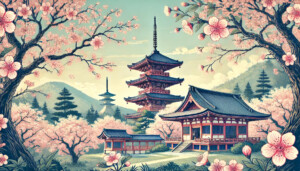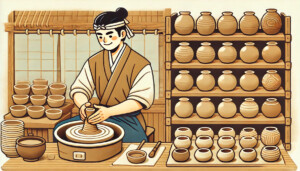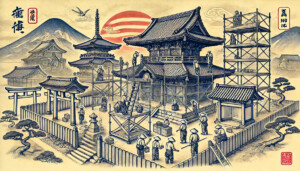1. Introduction
Japan, an archipelago rich in history and tradition, boasts a cultural heritage that spans centuries. From ancient temples and shrines to intricate crafts and customs, Japan’s cultural heritage is a tapestry of art, history, and tradition. This article delves into the various facets of Japanese cultural heritage, highlighting significant heritage sites, traditional crafts, and the ongoing efforts to preserve these invaluable treasures.
2. Japanese Heritage Sites
Subsection: Overview of Significant Heritage Sites
Japan’s landscape is dotted with numerous heritage sites, many of which are recognized as UNESCO World Heritage sites. These sites offer a glimpse into Japan’s rich history and cultural evolution.
UNESCO World Heritage Sites:

- Historic Monuments of Ancient Kyoto: Kyoto, once the capital of Japan, is home to countless temples, shrines, and gardens. Notable sites include Kinkaku-ji (Golden Pavilion), Ginkaku-ji (Silver Pavilion), and Ryoan-ji with its famous rock garden.
- Historic Villages of Shirakawa-go and Gokayama: These villages are renowned for their gassho-zukuri farmhouses, which have steep thatched roofs designed to withstand heavy snowfall.
- Itsukushima Shrine: Located on Miyajima Island, this Shinto shrine is famous for its “floating” torii gate, which appears to float on the water during high tide.
Subsection: Cultural and Historical Significance
Ancient Temples and Shrines:

- Senso-ji Temple: Located in Tokyo, Senso-ji is Tokyo’s oldest temple, founded in the 7th century. It is dedicated to Kannon, the Buddhist goddess of mercy.
- Fushimi Inari Shrine: Known for its thousands of vermilion torii gates, this shrine in Kyoto is dedicated to Inari, the Shinto god of rice.
- Todaiji Temple: Located in Nara, Todaiji houses the world’s largest bronze statue of Buddha (Daibutsu) and is a UNESCO World Heritage site.
Historical Landmarks:
- Himeji Castle: Also known as the White Heron Castle due to its elegant, white appearance, Himeji Castle is a prime example of Japanese feudal architecture.
- Horyuji Temple: One of the oldest wooden buildings in the world, Horyuji in Nara is a treasure trove of Buddhist art and artifacts.
3. Traditional Japanese Crafts
Subsection: Introduction to Traditional Crafts
Japan’s traditional crafts are a testament to the country’s artistic ingenuity and dedication to preserving age-old techniques. These crafts include pottery, lacquerware, textiles, and more.
Overview of Traditional Crafts:

- Pottery: Japanese pottery, such as Raku, Shino, and Oribe ware, is celebrated for its unique glazes and forms.
- Lacquerware: Japanese lacquerware, or urushi, is known for its durability and exquisite decoration, often featuring gold and silver inlays.
- Textiles: Japan’s textile tradition includes kimono fabric, silk weaving, and the intricate art of sashiko embroidery.
Subsection: Detailed Exploration of Specific Crafts
Pottery:
- Raku Ware: Originating in Kyoto, Raku ware is hand-shaped rather than wheel-thrown and is known for its rustic simplicity. It is closely associated with the Japanese tea ceremony.
- Shino Ware: Characterized by its thick white glaze and vibrant red underglaze, Shino ware is one of Japan’s oldest styles of pottery.
- Oribe Ware: Named after the tea master Furuta Oribe, this pottery features bold green and black glazes with free-form designs.
Lacquerware:
- Maki-e: This technique involves sprinkling gold or silver powder onto wet lacquer to create intricate designs. The result is a stunning, durable piece of art.
- Negoro-nuri: This style of lacquerware features layers of red and black lacquer, which wear over time to reveal the contrasting color beneath, creating a unique patina.
Textiles:
- Kimono Fabric: Traditional kimono fabrics, such as silk, are woven and dyed using techniques like yuzen and katazome. These fabrics often feature intricate patterns and motifs.
- Sashiko Embroidery: Originally used to reinforce fabric, sashiko has evolved into an art form, with white thread creating geometric patterns on indigo-dyed cloth.
Profiles of Master Craftsmen:
- Shoji Hamada: A celebrated potter and Living National Treasure, Hamada played a key role in the mingei (folk craft) movement.
- Shinsaku Hamada: Following in his father’s footsteps, Shinsaku continues to produce stunning pottery that blends tradition with modern aesthetics.
- Kunihiko Moriguchi: A Living National Treasure, Moriguchi is known for his work in yuzen dyeing, creating vibrant, intricate kimono designs.
4. Preservation Efforts
Subsection: Importance of Preserving Cultural Heritage
Preserving cultural heritage is crucial for maintaining a nation’s identity and passing down traditions to future generations. In Japan, both government and private initiatives play a significant role in these efforts.
Government Initiatives:
- Agency for Cultural Affairs: This government body is responsible for the protection and promotion of cultural heritage in Japan. It oversees the designation of Important Cultural Properties and National Treasures.
- Cultural Property Protection Law: Enacted in 1950, this law aims to preserve cultural properties, including buildings, artworks, and crafts.
Subsection: Challenges and Solutions
Challenges:
- Urbanization: Rapid urban development poses a threat to historical sites and traditional crafts.
- Aging Population: Many master craftsmen are aging, with few young apprentices to carry on their traditions.
- Natural Disasters: Japan’s frequent earthquakes and typhoons can damage or destroy cultural heritage sites.

Innovative Solutions and Community Efforts:
- Revitalization Projects: Initiatives like the “Revitalize Local Communities” project aim to breathe new life into rural areas through cultural tourism and craft workshops.
- Apprenticeship Programs: Organizations such as the Japan Traditional Crafts Aoyama Square offer training programs to encourage the next generation of craftsmen.
- Digital Preservation: Projects like Google Arts & Culture’s “Preserving Traditional Japanese Crafts” use digital technology to document and share information about traditional crafts.
5. Conclusion
In conclusion, Japan’s cultural heritage is a rich tapestry woven from its historic sites, traditional crafts, and the ongoing efforts to preserve these treasures. Understanding and appreciating this heritage is crucial for maintaining Japan’s cultural identity and ensuring that future generations can enjoy and learn from these traditions. By exploring Japan’s heritage sites, discovering its traditional crafts, and supporting preservation efforts, we can all play a part in keeping Japan’s cultural heritage alive.
Comment